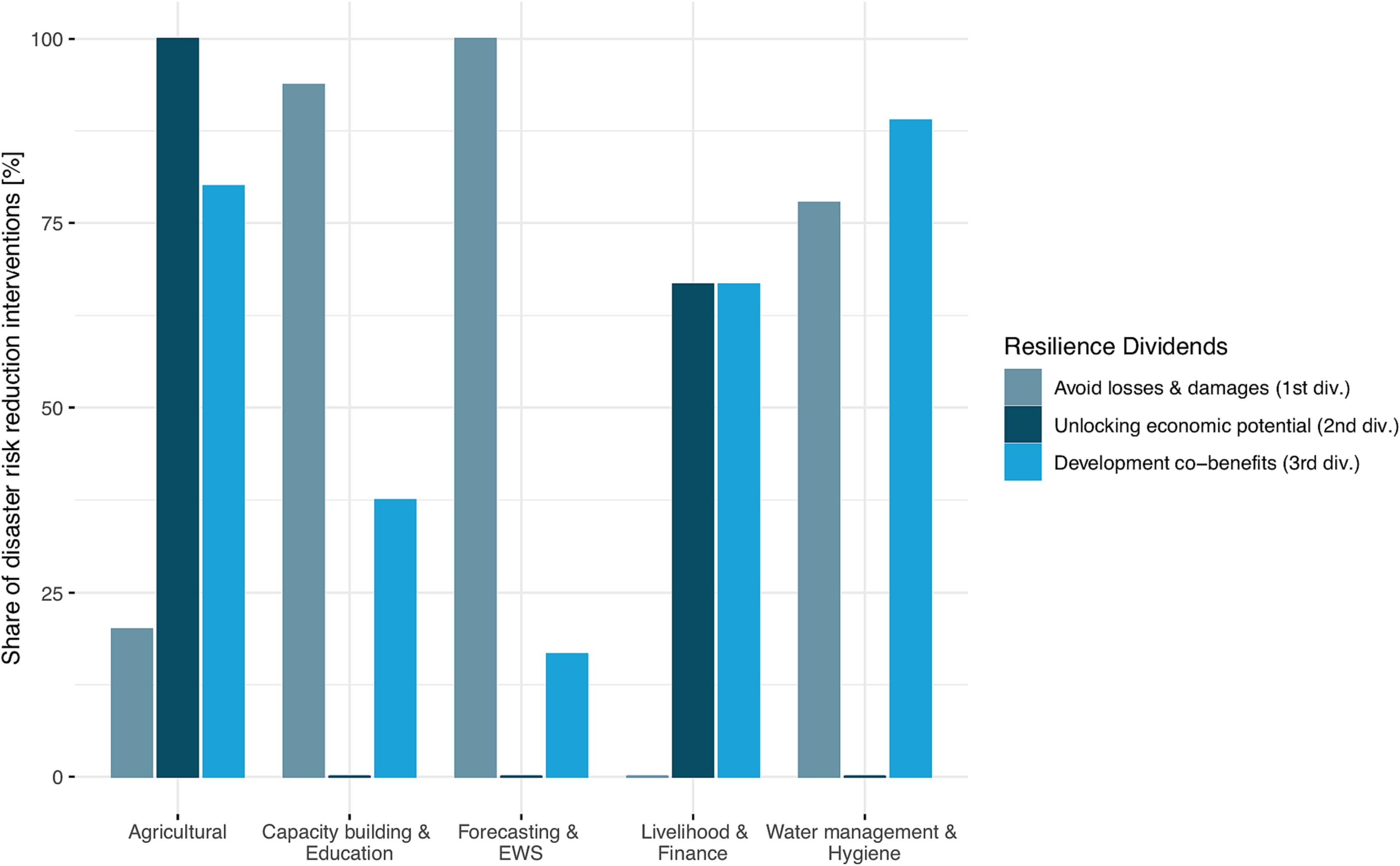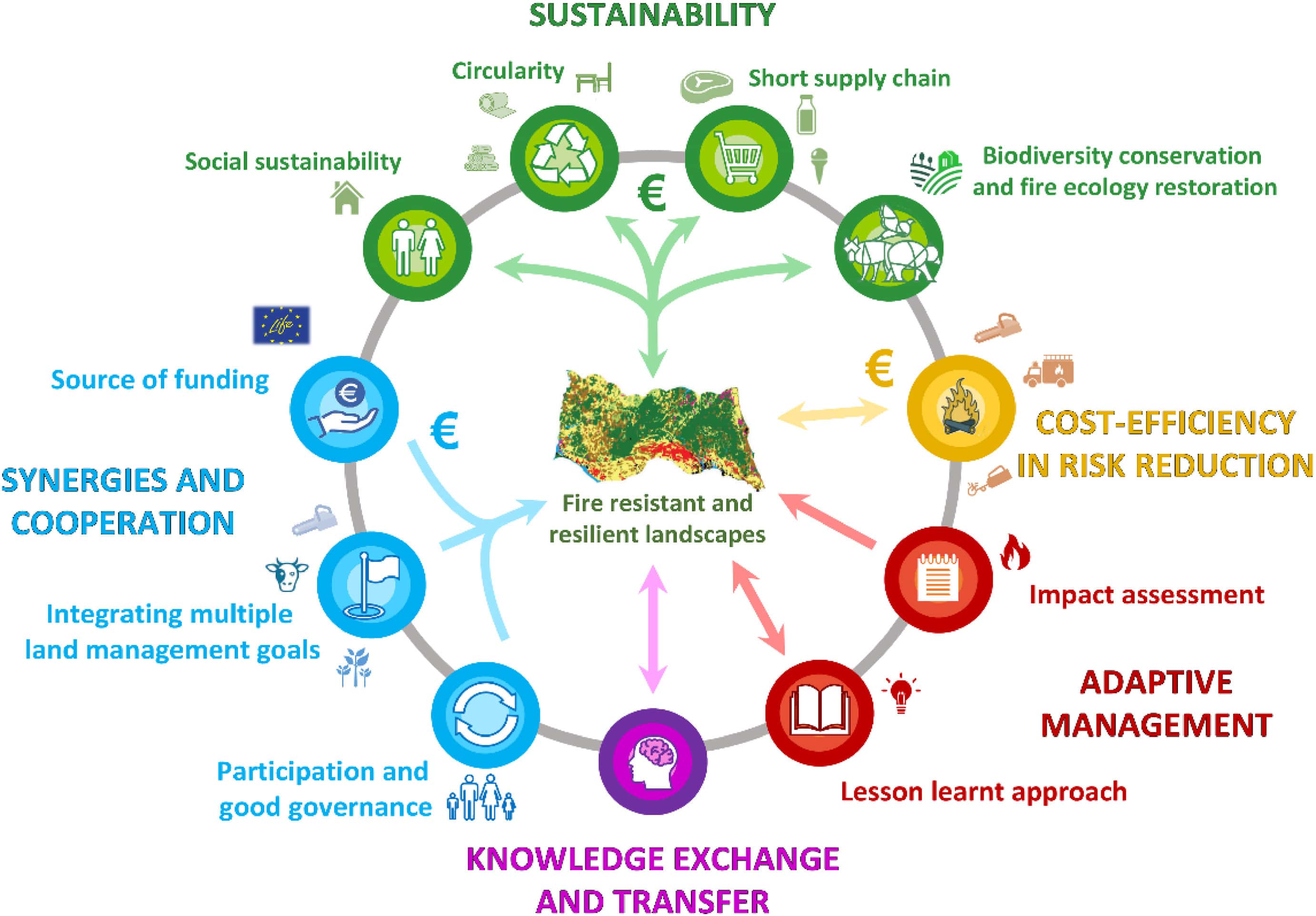Business case for DRR: Why investing in DRR makes sense
Investing in disaster risk reduction (DRR) saves lives and money and future-proofs our development gains.
Investments in DRR not only curb disaster losses. They also yield economic, social and environmental benefits that enhance the well-being and resilience of countries and communities. The benefits of adaptation investments are often larger than the “avoided losses” that accrue when disaster does strike; this is what's called the triple dividend of resilience.
The resilience dividends across the SDGs
The triple dividend of building resilience (TDR) is an approach that considers avoided losses (first dividend), induced economic or development benefits (second dividend), and additional social and environmental benefits (third dividend) of disaster risk reduction actions. The second and third dividend accrue regardless of whether the actual risk materializes.
Point of attention
When using the below information, it is recommended, to cite the original source, and not use a statistic out of context.
Learn more and explore this guidance.
Resilient infrastructure
- In low- and middle-income countries, investing in more resilient infrastructure yields US $4 in benefit for each $1 invested.
- Investing in low carbon microgrids can increase disaster resilience, while contributing to emission reduction.
- Society enjoys a benefit-cost ratio (BCR) of 11:1 for adopting the 2018 International Residential Code (IRC) and International Building Code (IBC).
Preparedness
- According to a 2009 study, $1 spent on preparedness is worth about $15 in terms of the future damage it mitigates.
- A cost-benefit analysis (CBA) in Georgia, finds that the USD 2.4 million of external support to the disaster risk management programme of Georgia Red Cross Society (GRCS), launched in 2010, has paid off extremely well. In the three surveyed areas, identified benefit-cost ratios range between 12.51 and 54.54.
Zambia and Tanzania reap the benefits from DRR investments
The examples of Tanzania and Zambia show that governments and other stakeholders in developing countries can spur economic growth by investing in DRR measures, thus increasing future earnings and creating a safe environment for investments into other economic activities.
For instance, constructing only two additional dams leads to a 0.3% increase of GDP growth in Tanzania for the next 30 years (0.2% in Zambia) with results largely (97%) driven by the co-benefit production expansion effect. Similarly, the introduction of drought resistant crops and exposure management (i.e., land use restrictions) significantly boost economic growth perspectives.
Early warning and early action
- Just 24 hours warning of a coming storm or heat wave can cut the ensuing damage by 30 percent. Spending US $800 million on such systems in developing countries would avoid losses of US $3–16 billion per year.
- Potential benefits from avoided losses could be as much as US $66 billion.
- Reliable and accurate early warning systems create benefits worth at least ten times their cost of implementing, saving lives and assets.
- Improvements made in National Meteorological Hydrological Services in order to reduce disaster losses in developing countries may generate benefit-cost ratios (BCRs) from 4 to 1 to 36 to 1.
- Climate services investments overall have a cost benefit ratio of one to 10.
- In Bangladesh, cyclone early warnings have significantly decreased the number of cyclone-related fatalities. During the Cyclone Matmo-Bulbul in 2019, less than 20 lives were lost, and 2.1 million people were safely evacuated to evacuation centres.
- In Samoa, according to a 2019 study, for every US $1 invested in early warning services for cyclones, there is a return of US $6 as a benefit.
- A study shows that 50% more accurate forecasts are worth at least US$2.1 billion per year based on the mortality benefits alone.
Resilience dividends from DRR interventions

Employment and poverty reduction
- Investing in resilience can foster economic growth and employment. ILO estimates that every US $1 million invested in climate adaptation infrastructure in the construction sector creates close to 650 jobs in India, 200 in China, 160 both in Brazil and in Indonesia, and 120 in the Russian Federation.
- Options to build people’s resilience, such as financial inclusion or social protection measures, are also good poverty reduction and development policies. In Bangladesh for example, reducing the exposure of poor people could prevent asset losses of $360 million a year, generating well-being gains equivalent to $1.5 billion a year
Economic benefits
- In the Pratomagno area in Italy, heather is harvested along fuelbreaks. The harvested heather is used to produce biological brooms. Consumers are willing to pay 17% more than the market price for these brooms to support fire prevention and protect wildlife habitat.
- In Spain, herds of sheep, goats and cows get deployed to graze at the edge of the forest. This helps prevent wildfires from spreading to populated areas. Dairy products have a label certifying the fuel management activity to inform consumers about the herds’ role in fire risk management. Shepherds receive public subsidies for each hectare grazed within the initiative.
- After the “Mompantero fire” in Italy, an initiative sought to reduce hazardous dead-wood accumulation. The wood is gathered and transformed into furniture. The product branding draws attention to the problem of extreme wildfires. The campaign increased sales of the products tenfold between 2018 and 2022.
Food security and agriculture
- Climate services such as seasonal forecasts, drought advisories and fire danger indices improve agricultural yields and strengthen food security. Climate services investments overall have a cost benefit ratio of one to 10.
- Risk reduction measures at farm level can yield many economic, social and environmental benefits. In Zimbabwe for instance, farmers using drought-tolerant maize were able to harvest up to 600 kilograms more maize per hectare than with conventional maize.
- Research in Belize shows that in some areas, even small amounts of mangrove restoration can have big tourism and fisheries benefits. While storing and sequestering millions of tons of carbon and boosting lobster fisheries by 66%, this research claims mangrove tourism may be worth several million dollars annually and reduces the risk of coastal hazards for at least 30% more people.
- Two flood-resistant rice varieties are helping farmers in Africa to improve productivity, with huge potential returns for countries affected by climate change, agricultural food experts say.

Urban resilience
DRR investments in cities not only reduce disaster risk, they also improve the quality of life in urban settings.
- An investment in smart surface technologies - such as solar roofs, green roofs, and porous and high albedo pavements - would result in net present values of US $1.8 billion in Washington, D.C., US $3.6 billion in Philadelphia and US $540 million El Paso over a 40-year period. These technologies can effectively address the severe cost of worse air quality, higher pollution and excess heat in urban low-income areas
- Trees and vegetation can lower local land temperatures by up to 5-6℃ on days of extreme heat, reducing energy use for air conditioning. Urban forests also improve the quality of life in cities: they reduce air and noise pollution; help filter and regulate water and provide spaces for recreation and physical activity.
Nature-based solutions
Built infrastructure systems can be supported by nature-based solutions to reduce disaster risk, while strategically conserving or restoring ecosystems and supporting livelihoods.
- Mangrove forests provide more than US $80 billion per year in avoided losses from coastal flooding—and protect 18 million people. They also contribute almost up to US $50 billion per year in non-market benefits (fisheries, forestry, and recreation). Combined, the benefits of mangrove preservation and restoration are up to 10 times the costs.
- Robust coral reefs can reduce wave energy by 97% and wave height by up to 88%, a degree of protection equivalent or at times superior to many engineering structures.
- A large-scale floodplain restoration programme would have many benefits in Europe, including reduced costs for dike reinforcement (€229 million), reduced flood risk (€1360 million), more flexibility in flood risk strategies in the long-term, and diversification of economy (e.g. tourism: €1152 million and fishery: €140 million) in the long term and job provision in the short term (supporting ~200.000 jobs).
- Evidence collated by the United Kingdom's Environment Agency shows that natural flood management effectively reduces the overall damage from flood risk. Research looked at ten natural flood management schemes created by individual Wildlife Trusts. Collectively, they had an average total cost-benefit ratio of 4:1 over ten years, rising to 10:1 over 30 years (every £1 invested in natural flood management (NFM) is expected to deliver £10 of benefits).
Water
- Securing water for our societies by 2030 could cost just over 1% of global GDP — about 29 cents per person, per day from 2015-2030. The economic benefits clearly outweigh the costs: every dollar invested in water access and sanitation yields an average $6.80 in returns.
- In Kenya, drought resilience building could save US$1.3 billion, or an average of US$84 million per year, when avoided losses are incorporated over 15 years over the cost of a late humanitarian response.
Capitalizing on the secondary benefits of investments in urban flood protection
A recent study highlights how an investment in urban flood protection can have many additional or secondary benefits across several areas: society, the economy, the environment, and infrastructure systems.
Here are three action points to help incorporate these benefits into the decision-making process:
- Take advantage of research and technological advancements, to better understand and assess the full range of benefits that flood protection measures can provide.
- Adopt a more holistic approach to cost-benefit analysis, to better capture and quantify the secondary benefits of urban flood protection measures.
- Plan ahead by incorporating nature-based solutions into flood protection strategies and exploring alternative financing mechanisms, to maximize a project’s secondary benefits and incentivize private sector participation.

The cost of inaction
Research suggests that the cost of climate change is widely underestimated. If we do not invest in climate action and disaster risk reduction, the economic and human toll of disasters will rise dramatically.
- The number of people in need of humanitarian assistance as a result of storms, droughts and floods could climb beyond 200 million annually by 2030 – compared to an estimated 108 million today. This rising human toll would come with a huge financial price tag, with climate-related humanitarian costs ballooning to US$20 billion per year by 2030, in the most pessimistic scenario.
- Failing to implement better water management policies could result in regional GDP losses from 2-10% by 2050.
- The worsening impact of climate change could displace 140 million people within their countries borders by 2050.
The opportunity
COVID-19 has disrupted billions of lives and laid bare severe and systemic inequalities. As the world plunges in the deepest global recession since WWII, the United Nations is calling for a large-scale, coordinated and comprehensive relief package - amounting to at least 10% of the global economy.
This unprecedented level of investment provides a once in a lifetime opportunity to build back better and steer the world onto a safer, healthier, more sustainable and inclusive path. We must ensure the resources poured into these investments are not lost to disasters, and that new infrastructure doesn’t translate into new risks.
The Sendai Framework sets out an agreed global blueprint for addressing risk. We must strengthen the capacity of people, communities, countries and systems to understand risk, withstand and bounce back from shocks, persist through stresses and transform through crises.
We must act with urgency and with greater ambition, proportional to the scale of the threat.
Last updated on: 22 October 2024



